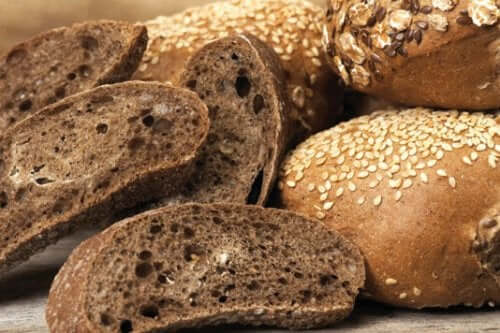Why You Should Encourage Your Children to Eat Wholemeal Food

Teaching children to eat healthily is key to the prevention of many diseases. One of the aspects we need to emphasize is why you should get your children used to eating wholemeal food products. Experts have shown us the whole range of benefits that it has for our health, as we’ll see below.
How does a wholemeal cereal differ from a refined one?
First of all, cereals are gramineous (grass) plants and their fruits are ripe, whole, healthy, and dry. They’re formed by a dry fruit (the kernel) surrounded by a layer that protects the germ and the endosperm, where we find the bran and the flour. We’re talking here about rice, pasta, quinoa, millet, buckwheat, spelt, oats, etc.
For a cereal to be considered wholemeal, or whole grain, it must contain at least the bran and the rest of the components except the germ. In addition, the degree of extraction to obtain the flour must be 95% or more. In this way, it’ll conserve all the vitamins and minerals, as well as the fiber.
We find the fiber in the bran, and when it’s removed, it’s lost, even though it’s added later on in the process. For this reason, a regulation about the denomination of wholemeal products arose.

This regulation establishes that only those products made with 100% whole grain flour may include the term wholemeal. This regulation prohibits the use of refined flours to which bran has been added, or a mixture of different flours with a lower percentage as it can mislead the consumer.
Why get children used to eating wholemeal food products?
The main reason is because of its high fiber content, as experts have shown it to be beneficial in the prevention and management of digestive and metabolic pathologies. It’s a nutrient present in vegetables and fruit, which has the capacity to satiate hunger.
In addition to this, the intestinal bacteria digest and ferment it and regulate the digestion and absorption of nutrients linked to the generation of short-chain fatty acids. In this way, you’ll notice an improvement in the quality and quantity of these nutrients.
Regarding overweight and obesity, the consumption of whole grains helps to reduce body weight and the accumulation of fat located around the organs. It also reduces the risk of suffering from cardiovascular diseases in adulthood. And, if that weren’t enough, it even lowers cholesterol levels, especially LDL and blood pressure.
Wholemeal products also improve insulin sensitivity, since fiber slows down the absorption of starch. This makes it impossible for blood glucose peaks to be sustained over a long period of time. However, exactly why this occurs is somewhat of a mystery.
Taking all of this into account, it’s a staple food type, which your child should take, along with fruit, vegetables and legumes to help prevent the onset of type 2 diabetes.
Wholemeal products also decrease the risk of colorectal cancer and constipation, as they speed up our intestinal transit, increase the fecal mass and the frequency of evacuation.
Generally, children barely reach the recommended doses of fiber, which are 0.5 oz per 1000 kcal, which should increase to 1 oz daily from adolescence.

Tips for cooking appetizing whole grain foods
Remember, the sooner you offer your children whole-grain food products, the easier it will be for them to accept them. Although, having said that, it’s never too late to exchange the refined ones for these superior products. However, it’s best to do this in a progressive way, following the advice we’ll give you below:
- Start by replacing the bread for their sandwiches.
- Prepare oatmeal soaked in milk or a plant-based drink with cocoa and some fruit or peanut butter for breakfast. They’ll come back for more!
- Cook the wholemeal rice and pasta with double the amount of water and double the time. In the case of rice, it will take 20 minutes. Use around 2 ounces to accompany the dishes.
- Mix the pasta or rice with the vegetables they like, or serve it with meat or fish. You can make the rice in a casserole with broth and vegetables. You can even add tomato sauce or home-made bolognese sauce.
- Let the rice or pasta cool in the fridge and add them to a salad.
Understand the benefits
As you’ve seen, it’s essential that you know and understand the benefits of getting children used to eating wholemeal food. Including it in their diet will ensure that they get their daily recommended fiber intake, and, at the same time, you’ll be giving them good variety in their eating habits. So, what are you waiting for? Follow our advice and improve your family’s eating habits and health!
Teaching children to eat healthily is key to the prevention of many diseases. One of the aspects we need to emphasize is why you should get your children used to eating wholemeal food products. Experts have shown us the whole range of benefits that it has for our health, as we’ll see below.
How does a wholemeal cereal differ from a refined one?
First of all, cereals are gramineous (grass) plants and their fruits are ripe, whole, healthy, and dry. They’re formed by a dry fruit (the kernel) surrounded by a layer that protects the germ and the endosperm, where we find the bran and the flour. We’re talking here about rice, pasta, quinoa, millet, buckwheat, spelt, oats, etc.
For a cereal to be considered wholemeal, or whole grain, it must contain at least the bran and the rest of the components except the germ. In addition, the degree of extraction to obtain the flour must be 95% or more. In this way, it’ll conserve all the vitamins and minerals, as well as the fiber.
We find the fiber in the bran, and when it’s removed, it’s lost, even though it’s added later on in the process. For this reason, a regulation about the denomination of wholemeal products arose.

This regulation establishes that only those products made with 100% whole grain flour may include the term wholemeal. This regulation prohibits the use of refined flours to which bran has been added, or a mixture of different flours with a lower percentage as it can mislead the consumer.
Why get children used to eating wholemeal food products?
The main reason is because of its high fiber content, as experts have shown it to be beneficial in the prevention and management of digestive and metabolic pathologies. It’s a nutrient present in vegetables and fruit, which has the capacity to satiate hunger.
In addition to this, the intestinal bacteria digest and ferment it and regulate the digestion and absorption of nutrients linked to the generation of short-chain fatty acids. In this way, you’ll notice an improvement in the quality and quantity of these nutrients.
Regarding overweight and obesity, the consumption of whole grains helps to reduce body weight and the accumulation of fat located around the organs. It also reduces the risk of suffering from cardiovascular diseases in adulthood. And, if that weren’t enough, it even lowers cholesterol levels, especially LDL and blood pressure.
Wholemeal products also improve insulin sensitivity, since fiber slows down the absorption of starch. This makes it impossible for blood glucose peaks to be sustained over a long period of time. However, exactly why this occurs is somewhat of a mystery.
Taking all of this into account, it’s a staple food type, which your child should take, along with fruit, vegetables and legumes to help prevent the onset of type 2 diabetes.
Wholemeal products also decrease the risk of colorectal cancer and constipation, as they speed up our intestinal transit, increase the fecal mass and the frequency of evacuation.
Generally, children barely reach the recommended doses of fiber, which are 0.5 oz per 1000 kcal, which should increase to 1 oz daily from adolescence.

Tips for cooking appetizing whole grain foods
Remember, the sooner you offer your children whole-grain food products, the easier it will be for them to accept them. Although, having said that, it’s never too late to exchange the refined ones for these superior products. However, it’s best to do this in a progressive way, following the advice we’ll give you below:
- Start by replacing the bread for their sandwiches.
- Prepare oatmeal soaked in milk or a plant-based drink with cocoa and some fruit or peanut butter for breakfast. They’ll come back for more!
- Cook the wholemeal rice and pasta with double the amount of water and double the time. In the case of rice, it will take 20 minutes. Use around 2 ounces to accompany the dishes.
- Mix the pasta or rice with the vegetables they like, or serve it with meat or fish. You can make the rice in a casserole with broth and vegetables. You can even add tomato sauce or home-made bolognese sauce.
- Let the rice or pasta cool in the fridge and add them to a salad.
Understand the benefits
As you’ve seen, it’s essential that you know and understand the benefits of getting children used to eating wholemeal food. Including it in their diet will ensure that they get their daily recommended fiber intake, and, at the same time, you’ll be giving them good variety in their eating habits. So, what are you waiting for? Follow our advice and improve your family’s eating habits and health!
All cited sources were thoroughly reviewed by our team to ensure their quality, reliability, currency, and validity. The bibliography of this article was considered reliable and of academic or scientific accuracy.
- BOE. Real Decreto 308/2019, de 26 de abril, por el que se aprueba la norma de calidad para el pan.
- Korczak, R.; Kamil, A.; Fleige, L.; Donovan, S. M; Slavin, J L. (2017) Dietary fiber and digestive health in children. Nutr Rev, 75(4): 241-59.
- Dahl, W J y Stewart, M L. (2015) Position of the Academy of Nutrition and Dietetics: Health Implications of Dietary Fiber. J Acad Am Nutr, 115(11): 1861-70.
- Kranz, S; Brauchla, M; Slavin, J L; Miller, K B (2012) What Do We Know About Dietary Fiber Intake in Children and Health? The Effects of Fiber Intake on Constipation, Obesity, and Diabetes in Children. Adv Nutr, 3(1):47-53.
- Edwards, C A; Xie, C y Garcia, A L. (2015) Dietary Fibre and Health in Children and Adolescents. Proc Nutr Soc, 74(3): 292-302.
- Zhang, B; Zhao, Q; Guo, W ;Bao, W; Wang, X (2018) Association of Whole Grain Intake With All-Cause, Cardiovascular, and Cancer Mortality: A Systematic Review and Dose-Response Meta-Analysis From Prospective Cohort Studies. Eur J Clin Nutr, 72(1): 57-65.
This text is provided for informational purposes only and does not replace consultation with a professional. If in doubt, consult your specialist.








